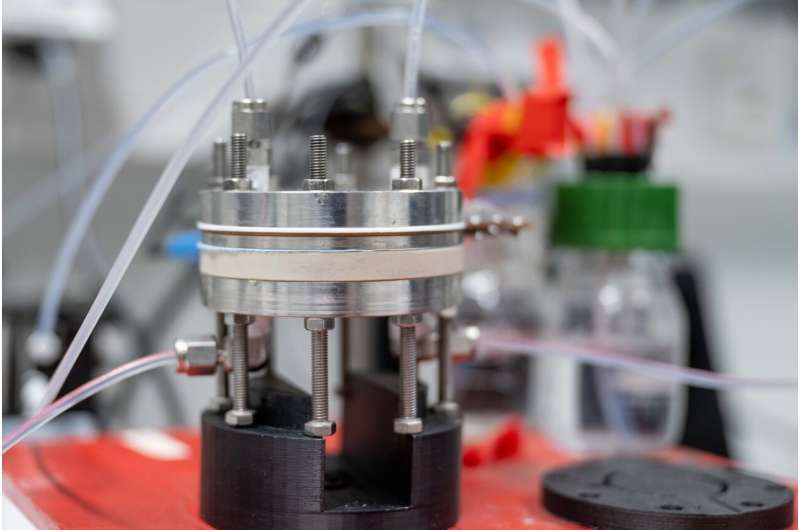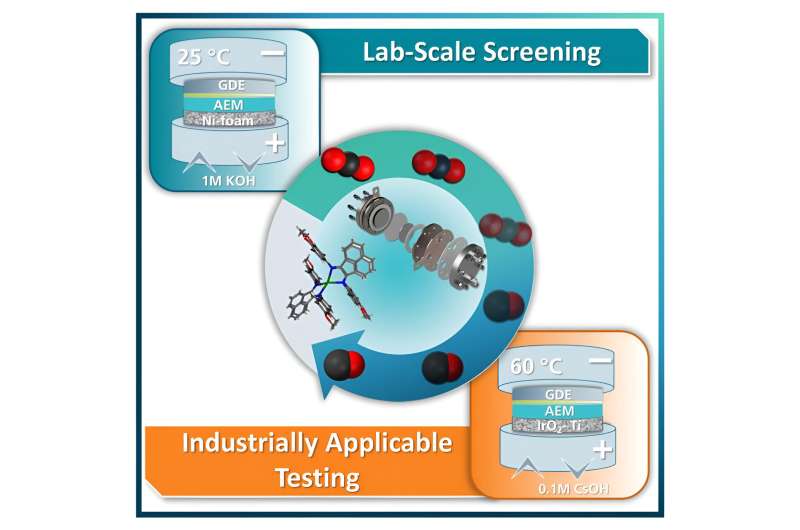This article has been reviewed according to Science X's editorial process and policies. Editors have highlighted the following attributes while ensuring the content's credibility:
fact-checked
peer-reviewed publication
trusted source
proofread
Research team designs a novel catalyst system for CO₂ conversion

Research groups around the world are developing technologies to convert carbon dioxide (CO2) into raw materials for industrial applications. Most experiments under industrially relevant conditions have been carried out with heterogeneous electrocatalysts, i.e., catalysts that are in a different chemical phase to the reacting substances. However, homogeneous catalysts, which are in the same phase as the reactants, are generally considered to be more efficient and selective. To date, there haven't been any set-ups where homogeneous catalysts could be tested under industrial conditions.
A team headed by Kevinjeorjios Pellumbi and Professor Ulf-Peter Apfel from Ruhr University Bochum and the Fraunhofer Institute for Environmental, Safety and Energy Technology UMSICHT in Oberhausen has now closed this gap. The researchers outlined their findings in the journal Cell Reports Physical Science. The article was published on December 13, 2023.
"Our work aims to push the boundaries of technology in order to establish an efficient solution for CO2 conversion that will transform the climate-damaging gas into a useful resource," says Ulf-Peter Apfel. His group collaborated with the team led by Professor Wolfgang Schöfberger from the Johannes Kepler University Linz and researchers from the Fritz Haber Institute in Berlin.
Efficiency and long-lasting stability
The team explored the conversion of CO2 using electrocatalysis. In the process, a voltage source supplies electrical energy, which is fed to the reaction system via electrodes and drives the chemical conversions at the electrodes. A catalyst facilitates the reaction; in homogeneous electrocatalysis, the catalyst is usually a dissolved metal complex. In a so-called gas diffusion electrode, the starting material CO2 flows past the electrode, where the catalysts convert it into carbon monoxide. The latter, in turn, is a common starting material in the chemical industry.
The researchers integrated the metal complex catalysts into the electrode surface without bonding them to it chemically. They showed that their system could efficiently convert CO2: It generated current densities of more than 300 milliamperes per square centimeter. Moreover, the system remained stable for over 100 hours without showing any signs of decay.

No need to anchor the catalyst
All this means that homogeneous catalysts can generally be used for electrolysis cells. "However, they do require a specific electrode composition," says Ulf-Peter Apfel. More specifically, the electrodes must enable direct gas conversion without solvents so that the catalyst isn't leached from the electrode surface. Contrary to what is often described in specialist literature, there's no need for a carrier material that chemically couples the catalyst to the electrode surface.
"Our findings open up the possibility of testing and integrating high-performance and easily variable homogeneous electrocatalysts in application scenarios for electrochemical processes," concludes Apfel.
More information: Kevinjeorjios Pellumbi et al, Pushing the Ag-loading of CO2 electrolyzers to the minimum via molecularly tuned environments, Cell Reports Physical Science (2023). DOI: 10.1016/j.xcrp.2023.101746
Journal information: Cell Reports Physical Science
Provided by Ruhr-Universitaet-Bochum





















